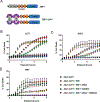ADAR1 mutation causes ZBP1-dependent immunopathology
- PMID: 35859177
- PMCID: PMC9339495
- DOI: 10.1038/s41586-022-04896-7
ADAR1 mutation causes ZBP1-dependent immunopathology
Abstract
The RNA-editing enzyme ADAR1 is essential for the suppression of innate immune activation and pathology caused by aberrant recognition of self-RNA, a role it carries out by disrupting the duplex structure of endogenous double-stranded RNA species1,2. A point mutation in the sequence encoding the Z-DNA-binding domain (ZBD) of ADAR1 is associated with severe autoinflammatory disease3-5. ZBP1 is the only other ZBD-containing mammalian protein6, and its activation can trigger both cell death and transcriptional responses through the kinases RIPK1 and RIPK3, and the protease caspase 8 (refs. 7-9). Here we show that the pathology caused by alteration of the ZBD of ADAR1 is driven by activation of ZBP1. We found that ablation of ZBP1 fully rescued the overt pathology caused by ADAR1 alteration, without fully reversing the underlying inflammatory program caused by this alteration. Whereas loss of RIPK3 partially phenocopied the protective effects of ZBP1 ablation, combined deletion of caspase 8 and RIPK3, or of caspase 8 and MLKL, unexpectedly exacerbated the pathogenic effects of ADAR1 alteration. These findings indicate that ADAR1 is a negative regulator of sterile ZBP1 activation, and that ZBP1-dependent signalling underlies the autoinflammatory pathology caused by alteration of ADAR1.
© 2022. The Author(s), under exclusive licence to Springer Nature Limited.
Conflict of interest statement
Competing interests
DBS is a co-founder and shareholder of Danger Bio, LLC, and a scientific advisor for Related Sciences LLC. AO is a co-founder and shareholder of Walking Fish Therapeutics.
Figures


















Comment in
-
ADAR1 inhibits ZBP1 activation by endogenous Z-RNA.Nat Rev Genet. 2022 Oct;23(10):581. doi: 10.1038/s41576-022-00525-1. Nat Rev Genet. 2022. PMID: 35922480 No abstract available.
-
Keeping immunostimulatory self-RNA under the rADAR.Nat Rev Rheumatol. 2022 Dec;18(12):681-682. doi: 10.1038/s41584-022-00859-4. Nat Rev Rheumatol. 2022. PMID: 36203062 No abstract available.
References
Main text references
Methods References
-
- Murphy JM et al. The pseudokinase MLKL mediates necroptosis via a molecular switch mechanism. Immunity 39, 443–453 (2013). - PubMed
MeSH terms
Substances
Grants and funding
LinkOut - more resources
Full Text Sources
Other Literature Sources
Medical
Molecular Biology Databases
Miscellaneous

